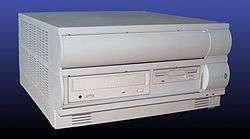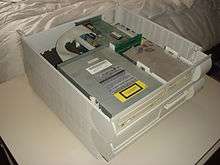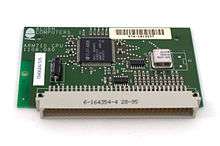RiscPC
 | |
 Acorn RiscPC 600 with two case slices, 3.5-inch disk drive and DVD-ROM drive. | |
| Developer | Acorn Computers |
|---|---|
| Manufacturer | Acorn Computers, Castle Technology[1] |
| Release date | 15 April 1994 |
| Discontinued | 11 November 2003[2] |
| Operating system | RISC OS |
| CPU | ARMv3/ARMv4 |
| Dimensions |
|
| Predecessor | Archimedes series |
| Successor | Phoebe, Iyonix PC, A9home |
| Related articles | A7000 |
The RiscPC (stylised with a half-space[3] as Risc PC, also referred to as Risc PC and codenamed Medusa) was Acorn Computers's next generation RISC OS/Acorn RISC Machine computer, launched on 15 April 1994,[4] which superseded the Acorn Archimedes.[5] The Acorn PC card and software allows PC compatible software to be run.
Like the Archimedes, the RiscPC continued the practice of having the RISC OS operating system in a ROM module. RiscPC augmented the ROM-based core OS with a disk-based directory structure containing configuration information, and some applications which had previously been kept in ROM. At the 1996 BETT Educational Computing & Technology Awards, the machine was awarded Gold in the hardware category.[6]
Specifications and technical details

- Memory type: Two 72-pin FPM SIMM slots, supporting a maximum memory size of 256 MiB.
- Video subsystem: VIDC20 controller, with optional dual-port VRAM up to 2 MiB.[7]
- Expansion: Eurocard-sized Podule support in common with Archimedes-series machines. The RiscPC also offers DMA support in the first two podules on the bus. Third parties produced similar cards.
- Operating system: RISC OS, stored in 4 MiB ROM (RISC OS 3.50 shipped on 2 MiB ROMs) supplemented by disc-based components.
- Fitted as standard:
- RISC OS 3.50 (RiscPC 600)
- RISC OS 3.60 (RiscPC 700)
- RISC OS 3.70 (StrongARM RiscPC)
- RISC OS 3.71 (StrongARM RiscPC J233)
- RISC OS 4.03 (Kinetic RiscPC)
- RISC OS 4, RISC OS Select, RISC OS Adjust and RISC OS 6 are available from RISCOS Ltd as a replacement for the Acorn-implemented versions.[8]
- RISC OS 5 from RISC OS Open with the CPU running in 32-bit mode.
- Linux – no longer supported.[9]
- NetBSD[10]
- Fitted as standard:
- Case: Designed by industrial designer Allen Boothroyd[11] of Cambridge Product Design (designer of the BBC Micro case). Custom plastic-based design with a 'slice' feature which allows extra case modules to be added to increase internal expansion space. Each slice adds two podule bays at the rear, and two drive bays (one 3.5-inch, one 5.25-inch) at the front, covered by a retractable flap to hide cosmetic inconsistencies in hue. Some slices were internally sprayed with nickel paint to meet electromagnetic and radio emissions regulations.
- CD-ROM drive: Optional extra, offering limited compatibility with multimedia PC CD-ROMs.[12]
- Ports: RS-232 serial, parallel, PS/2 keyboard, Acorn mouse, headphone audio out, DE15 VGA, network (optional).
- CPU: Dual-processor slots, one host processor and one guest processor.
 An ARM 710 CPU card for the RiscPC
An ARM 710 CPU card for the RiscPC The Acorn ACA56 Acorn PC card upgrade, showing the user guide, software disc and card itself
The Acorn ACA56 Acorn PC card upgrade, showing the user guide, software disc and card itselfHost processors:
Additionally prototypes of 33 MHz ARM700 and 55 MHz ARM810 processors were developed by Acorn, but not released.
Guest processors:
Additional configurations
- Hydra multi-processor development system from Simtec. This allowed an extra four ARM6 or ARM7 CPU cards. The Hydra add-on added multiprocessor functionality to the RiscPC with multiple Acorn ARM610 processors and the addition of the x86 co-processor card.
- Dimensions: 117 (182 for two centre-sections) × 355 × 384 mm (H×W×D).
Usage

The RiscPC was used in schools, studios of music composers and scorewriters (using Sibelius)[15] and television playout environments (using OmniBus).
Milestones
- 1994 – RiscPC 600 launched, featuring a 30 MHz ARM610 CPU.[5]
- 1995 – 40 MHz ARM710 CPU upgrade and RiscPC 700 model launched.[5]
- 1996 – 200 MHz StrongARM CPU upgrade released, offering a five-fold increase in raw processing power compared to the ARM7 used in the previous high-end machines.[16]
- 1997 – Acorn launch Acorn J233 StrongARM Risc PC, featuring an uprated 233 MHz model of StrongARM and including Browser and Java software.[17]
- 1998 – Castle Technology acquire the rights to continue to market and produce the RiscPC during the breakup of Acorn Computers.[18]
- 2000 – In May, Castle Technology reveal the Kinetic RiscPC range which included a faster processor card with onboard memory.[19]
- 2001 – Viewfinder Podule, AGP adapter allows the use of IBM PC clone AGP graphics cards (e.g. a range of ATI Rage and Radeon).[20]
- 2003 – Castle Technology announce the end of production and sale of the RiscPC.[18]
RiscPC 2
Acorn set about designing the RiscPC 2, later renamed to Phoebe 2100 – a design with a 64 MHz front side bus, PCI slots, and a yellow-coloured NLX form-factor case.[21] Slated for release in late 1998, the project was abandoned just before completion, when Acorn's Workstation Division was closed. Only two prototypes were ever built, and one was publicly displayed for historical interest at the RISC OS 2001 show in Berkshire, England;[22] the remaining cases were bought by CTA Direct who sold them off to the public.[23]
After Acorn
In 2003 it was confirmed that no more RiscPCs would be produced.[18] However RISC OS computers based on other ARM processors machines have been manufactured by companies since this date.
- Castle Technology – Iyonix PC based on the Intel XScale ARM processor and PCI bus
- Advantage Six – A9home based on the Samsung S3C2440 ARM processor
- RiscStation – R7500 based on the ARM7500-FE processor
Significantly better performance has been pulled out of the aged RiscPC design by using the newer 203 (and later 236) MHz StrongARM CPU, using third-party video cards, overclocking, and having specially-designed CPU cards with RAM located upon them to sidestep the speed bottleneck of the slow system bus.
Limitations
The 16 MHz front side bus is usually recognised as being the most significant fault of the computer; and the arrival of the (five times faster) StrongARM processor in 1996 meant that the RiscPC had a CPU significantly faster than the computer had been designed for. Acorn had originally expected ARM CPUs to progress from the 30 MHz ARM6 to the 40 MHz ARM7, and then onto the ARM8 cores, which at the time were clocked at around 50–80 MHz. In 2000, Castle released "Kinetic", a new StrongARM processor board with its own onboard memory slots augmenting main memory, reducing the need to negotiate the slow front side bus for memory accesses.
The podule bus on the RiscPC (i.e. 32-bit; predecessor systems to the RiscPC had 16-bit bus) can achieve a maximum data throughput of approximately 6100 KByte/s.[24] For comparison: the PCI bus, which was available in systems at the time of the RiscPC's introduction, is over 20 times faster (e.g. the transfer of 650 MB would take 2 minutes via podule, compared to 5 seconds via PCI).
See also
References
- ↑ Acorn Computers Ltd (1998-10-12). "Acorn announces distribution deal with Castle Technology for RISC based products". Press release. Acorn Computers Ltd. Archived from the original on 1999-05-06. Retrieved 2011-01-06.
(October 12th 1998), Cambridge, UK-Acorn announced today that it has completed negotiations with Castle Technology for them to distribute Acorn products.
- ↑ Mike Williams (11 November 2003). "Risc PC to Cease Production". Newsgroup: comp.sys.acorn.announce. Usenet: slrnbr2fvo.ngt.n.g.boalch@compsoc.dur.ac.uk.
|access-date=requires|url=(help) - ↑ "RISC OS FAQ Guidelines". riscos.info. Retrieved 30 August 2013.
- ↑ "Acorn launches the Risc PC" (PDF). Developers' Newsletter No. 33 – April 1994. Acorn Computers. 1994-04-30. Retrieved 2018-01-26.
... on Friday April 15th ...
- 1 2 3 "Chris's Acorns: Risc PC Computers". Chris Whytehead. 2009. Retrieved 2018-01-26.
- ↑ Stilwell, Geoff (Spring 1996). "BETT '96" (PDF). Eureka. p. 22. Retrieved December 30, 2011.
- ↑ "APDL RiscWorld". Application Note 254. Acorn Computers. 9 June 2003. Retrieved 9 July 2012.
- ↑ "Chris's Acorns: RISC OS Ltd". Chris Whytehead. 2009. Retrieved 2018-01-26.
- ↑ "ARM Linux Acorn Overview". ARMLinux. 2009. Retrieved August 13, 2009.
- ↑ "NetBSD/acorn32". NetBSD. 2009. Retrieved August 13, 2009.
- ↑ Burley, Ian (June 1994). "Acorn RISC PC 600" (PDF). Personal Computer World. Retrieved 30 August 2013.
- ↑ Lambert, Andy (October 20, 1995). "Trading on misguided loyalties?". Times Educational Supplement. Retrieved November 10, 2011.
Acorn has been pressed to give its users access to Windows Multimedia PC CDs ... there are still doubts about full compatibility.
- ↑ Penman, Danny (1994-04-15). "Computers: System that holds the right cards". The Independent. London. Retrieved September 6, 2011.
The modular design of the new computer allows a PC 486 processor to be added using a card ...
- ↑ "Used Acorn 586 ACA57 Risc PC IBM 5x86C 100MHz Second Generation PC Card". eBay. Retrieved 2017-11-08.
IBM 5x86C 100MHz Second Generation PC Card
- ↑
Bourgeois, Derek (2001-11-01). "Score yourself an orchestra". The Guardian. Guardian Media Group. Retrieved 2011-05-10.
Many composers bought an Archimedes simply to have access to the program.
- ↑ "Chris's Acorns: ART StrongARM CPU". Chris Whytehead. 2009. Retrieved 2018-01-26.
- ↑ Chris, Whytehead. "Acorn J233 StrongARM Risc PC".
- 1 2 3 "Castle bids farewell to RiscPC". Drobe. 2003. Retrieved 2018-01-26.
- ↑ "Castle reveal Kinetic to the press". Iconbar. 2000. Retrieved August 13, 2009.
- ↑ "Viewfinder 2 revealed". Drobe. 2002. Retrieved June 28, 2010.
- ↑ "Clan Newsletter August 1998". Acorn Computers. 1998. Retrieved August 19, 2009.
- ↑ "RiscPC 2 at RISC OS 2001". Drobe. 2001. Retrieved August 13, 2009.
- ↑ "Phoebe cases on sale". Iconbar. 2000. Retrieved August 19, 2009.
- ↑ "Podule Bus review".